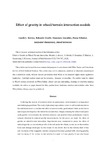Mostrar o rexistro simple do ítem
Effect of gravity in wheel/terrain interaction models
| dc.contributor.author | Kovács, László L. | |
| dc.contributor.author | Ghotbi, Bahareh | |
| dc.contributor.author | González Varela, Francisco Javier | |
| dc.contributor.author | Niksirat, Parna | |
| dc.contributor.author | Skonieczny, Krzysztof | |
| dc.contributor.author | Kövecses, József | |
| dc.date.accessioned | 2022-05-24T07:24:06Z | |
| dc.date.available | 2022-05-24T07:24:06Z | |
| dc.date.issued | 2020 | |
| dc.identifier.citation | Kovács, LL, Ghotbi, B, González, F, Niksirat, P, Skonieczny, K, Kövecses, J. Effect of gravity in wheel/terrain interaction models. J Field Robotics. 2020; 37: 754– 767. https://doi.org/10.1002/rob.21924 | es_ES |
| dc.identifier.uri | http://hdl.handle.net/2183/30734 | |
| dc.description.abstract | [Abstract] Predicting the motion of wheeled robots in unstructured environments is an important and challenging problem. The study of planetary exploration rovers on soft terrain introduces the additional need to consider the effect of non-terrestrial gravitational fields on the forces and torques developed at the wheel/terrain interface. Simply reducing the wheel load under earth gravity overestimates the travelled distance and predicts better performance than is actually observed in reduced-gravity measurements. In this paper, we study the effect of gravity on wheel/terrain interaction. Experiments were conducted to assess the effect of reduced gravity on the velocity profile of the soil under the wheel, as well as on the traction force and sinkage developed by the wheel. It was shown that in the velocity field of the soil, the decay of the tangential velocity component becomes gradual with reducing gravity, and the decay of the normal to rim velocity is slower in Lunar gravity. It was also found that wheel flexibility can have an important effect on the dynamics as the contact patch and effective radius varies periodically. These results were then used together with traditional semi-empirical terramechanics models to determine and validate the simulated drawbar pull values. The developed simulation model includes the effect of wheel flexibility, dynamic sinkage and gravity. | es_ES |
| dc.description.sponsorship | MINECO; RYC-2016-20222 | es_ES |
| dc.language.iso | eng | es_ES |
| dc.relation.uri | https://doi.org/10.1002/rob.21924 | es_ES |
| dc.rights | Atribución-NoComercial-SinDerivadas 3.0 España | es_ES |
| dc.rights | This article may be used for non-commercial purposes in accordance with Wiley Terms and Conditions for Use of Self-Archived Versions. This article may not be enhanced, enriched or otherwise transformed into a derivative work, without express permission from Wiley or by statutory rights under applicable legislation. Copyright notices must not be removed, obscured or modified. The article must be linked to Wiley’s version of record on Wiley Online Library and any embedding, framing or otherwise making available the article or pages thereof by third parties from platforms, services and websites other than Wiley Online Library must be prohibited. | es_ES |
| dc.rights.uri | http://creativecommons.org/licenses/by-nc-nd/3.0/es/ | * |
| dc.subject | Modelling and simulation | es_ES |
| dc.subject | Reduced gravity experiment | es_ES |
| dc.subject | Velocity field | es_ES |
| dc.subject | Wheel flexibility | es_ES |
| dc.subject | Wheel-soil interaction | es_ES |
| dc.subject | Modelado y simulación | es_ES |
| dc.subject | Experimentos en gravedad reducida | es_ES |
| dc.subject | Campo de velocidades | es_ES |
| dc.subject | Flexibilidad de la rueda | es_ES |
| dc.subject | Interacción rueda-terreno | es_ES |
| dc.title | Effect of gravity in wheel/terrain interaction models | es_ES |
| dc.type | info:eu-repo/semantics/article | es_ES |
| dc.rights.access | info:eu-repo/semantics/openAccess | es_ES |
| UDC.journalTitle | Journal of Field Robotics | es_ES |
| UDC.volume | 37 | es_ES |
| UDC.issue | 5 | es_ES |
| UDC.startPage | 754 | es_ES |
| UDC.endPage | 767 | es_ES |
| dc.identifier.doi | 10.1002/rob.21924 |
Ficheiros no ítem
Este ítem aparece na(s) seguinte(s) colección(s)
-
LIM - Artigos [43]






